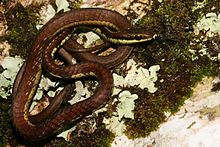Dendrelaphis schokari, also known as the common bronze-back[4] or Schokar's bronzeback[5] (Sinhala: තරු/මූකලන් හාල්දන්ඩා, Tharu/Mookalan Haaldanda in Sinhala[4]), is a species of non-venomous arboreal snake in the family Colubridae. The species is endemic to Sri Lanka.[3]
| Schokar's bronzeback | |
|---|---|

| |
| Scientific classification | |
| Domain: | Eukaryota |
| Kingdom: | Animalia |
| Phylum: | Chordata |
| Class: | Reptilia |
| Order: | Squamata |
| Suborder: | Serpentes |
| Family: | Colubridae |
| Subfamily: | Ahaetuliinae |
| Genus: | Dendrelaphis |
| Species: | D. schokari
|
| Binomial name | |
| Dendrelaphis schokari (Kuhl, 1820)
| |
| Synonyms[3] | |
| |
Taxonomy
editDendrelaphis schokari belongs to the genus Dendrelaphis, which contains 48 other described species.[6]
Dendrelaphis is one of five genera belonging to the vine snake subfamily Ahaetuliinae, of which Dendrelaphis is most closely related to Chrysopelea, as shown in the cladogram below:[7]
| Ahaetuliinae |
| ||||||
Habitat
editDendrelaphis schokari inhabits forests and open areas of all climatic zones of the island of Sri Lanka, from lowlands to about 750 m (2,460 ft) above sea level. It is diurnal, and though a tree snake, it is observed foraging on land as well.[2][8][9][10]
Diet
editIts prey consists of frogs, lizards, geckos, skinks, insects and also eggs of small birds. It can make long jumps among trees if necessary while chasing its prey.[2][8][9][10]
Description
editIt can be distinguished easily from other Dendrelaphis species by having a cream-colored spotted line on its olive green dorsum (back) from neck to mid fore body along the spine.[2][8][9][10]
Formal description
editDendrelaphis schokari adult female: snout-to-vent length (SVL) 51 cm (20 in); tail 22.5 cm (8.9 in); 161 ventrals (2 preventrals); 113 subcaudals, all divided; anal shield divided; 1 loreal scale (L+R); 9 infralabials (L+R); first infralabials touch at the mental groove; first sublabial touches infralabials 6 and 7 (L+R); 9 supralabials (L+R), supralabials 5 and 6 touch the eye (L+R); 2 postoculars (L+R); temporal formula: 2+2 (L+R); dorsal formula: 15-15-11; vertebral scales enlarged but smaller than the scales of the first dorsal row; width of the dorsal scale at the position of the middle ventral 2.1 mm; eye-diameter 4.9 mm (L+R); distance anterior border of eye to posterior border of nostril 4.5 mm (L+R); a dark postocular stripe starts behind the eye, covers only the lower quarter of the temporal region and ends at the edge of the jaw; a vertebral stripe, formed by yellow spots on the vertebral scales, starts behind the head and is no longer visible after the level of the 34th ventral scale; an interparietal spot is absent; a faint light ventrolateral line is present, not bordered by black lines; ground color brown, based on the color of unshed skin; supralabials and throat yellow; ventrals yellow anteriorly, yellowish-green posteriorly.[2]: 152 [8]: 33–43 [9]: 81–84 [10]: 583
References
edit- ^ Wickramasinghe, L.J.M.; Ganesh, S.R. (2021). "Dendrelaphis schokari". IUCN Red List of Threatened Species. 2021: e.T42492396A42492401. Retrieved 23 April 2023.
- ^ a b c d e Kuhl, Heinrich (1820). Beiträge zur Zoologie und vergleichenden Anatomie. Frankfurt am Main: Verlag der Hermannschen Buchhandlung. LCCN 06002733. 152 pp. (Dipsas schokari, new species, pp. 30-32). (in German and Latin).
- ^ a b Dendrelaphis schokari at the Reptarium.cz Reptile Database. Accessed 29 November 2018.
- ^ a b Bushana Kalhara (21 August 2010). "Common bronze-back/තුරු හාල්දණ්ඩා/මූකලන් හාල්දණ්ඩා[Thuru/Mookalan Haal Danda] (Dendrelaphis schokari)". Biodiversity of Sri Lanka: Snakes of Sri Lanka. Retrieved 4 December 2018.
- ^ Sanjaya Bandara (25 January 2018). "Schokar's Bronzeback/කූල්ගේ හාල්දණ්ඩා (Dendrelaphis schokari-Kuhl, 1820)". Snakes of Sri Lanka. Retrieved 4 December 2018.
- ^ Genus Dendrelaphis at The Reptile Database.
- ^ Mallik, Ashok Kumar; Achyuthan, N. Srikanthan; Ganesh, Sumaithangi R.; Pal, Saunak P.; Vijayakumar, S. P.; Shanker, Kartik (27 July 2019). "Discovery of a deeply divergent new lineage of vine snake (Colubridae: Ahaetuliinae: Proahaetulla gen. nov.) from the southern Western Ghats of Peninsular India with a revised key for Ahaetuliinae". PLOS ONE. 14 (7): e0218851. Bibcode:2019PLoSO..1418851M. doi:10.1371/journal.pone.0218851. ISSN 1932-6203. PMC 6636718. PMID 31314800.
- ^ a b c d van Rooijen, Johan; Vogel, Gernot (2008). "An investigation into the taxonomy of Dendrelaphis tristis (Daudin, 1803): revalidation of Dipsas schokari (Kuhl, 1820) (Serpentes, Colubridae)" (PDF). Contributions to Zoology. 77 (1): 33–43. doi:10.1163/18759866-07701005. S2CID 55045918.
- ^ a b c d Werner, Franz (1893). "Herpetologische Nova" (PDF). Zoologischer Anzeiger. 16 (414): 81–84.
- ^ a b c d Smith MA (1943). The Fauna of British India, Ceylon and Burma, Including the Whole of the Indo-Chinese Sub-Region. Reptilia and Amphibia. Vol. III.—Serpentes. London: Secretary of State for India. (Taylor and Francis, printers). xii + 583 pp.
